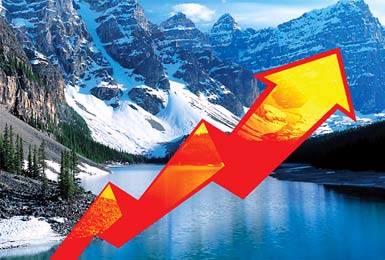Regional Report: The Mountain States Climb with Green Energy and Bioscience
Energy, biosciences, and manufacturing sectors are helping the Mountain States find economic stability during the Great Recession - and beyond.
September 2010

Positive Economic Indicators
Recent studies reflect the economic success of the Mountain States. Each month, up to 400 supply managers employed by manufacturing, mining, and utilities companies in Colorado, Utah, and Wyoming provide data for the Mountain States Leading Economic Indicator survey. The Goss Institute for Economic Research, a Denver economic development think tank, conducts the survey.
"If our survey respondents are seeing things good right now, then that indicates the economy will be good in about six months," says Ernest Goss, Ph.D., institute director and Jack A. MacAllister Chair in Regional Economics at Omaha's Creighton University. The June 2010 survey is optimistic, as it reveals "an overall consensus that the economy is crawling out of the recession. That will occur probably in the second half of 2010," Goss says.
The indicators have markedly improved from surveys conducted during the second half of 2009. June's results represent the ninth consecutive month that the leading economic indicators have been above "growth neutral."
How accurate is the monthly survey? In the past it's done a "pretty good job" of determining the direction of the regional economy, Goss says. Much of the anticipated recovery has to do with improvements in manufacturing. "The export market is looking better," Goss says. "We're seeing mining and natural resources industries improving even as oil prices have remained fairly stable."
The Gulf Coast oil spill and general concerns about off-shore drilling have renewed interest in land-based onshore drilling in Wyoming, Colorado, and Utah. In Wyoming, "there are some new areas of discovery where there will be increased drilling," Goss says. "The outlook is looking very promising."
Regarding alternative energies, wind and solar production in these three states is good, but "not as strong as advertised," Goss says, attributing slow growth to the federal government. "It takes a while for government policies and programs to be put in place, and business leaders are [still] trying to figure out where these policies are going," he says. And issues about distributing the alternative energies within and outside the Mountain States persist.
Other survey results show that supply managers reported significant commodity price bubbles, and that hiring was increasing while layoffs were decreasing. "Again, the overall economic numbers are better, but we're still not back to pre-recession levels," Goss says. "We have a ways to go yet."
Future Alternative Energy Boom
Clean Energy Leadership in the Rockies: Competitive Positioning in the Emerging Green Economy, a report by Headwaters Economics of Bozeman, Montana, provides encouraging news for the region's alternative energy initiatives. It focused on indicators of green economic success and policy leadership in Colorado, Montana, Utah, Wyoming, and New Mexico.
The green economy, as defined by the report, encompasses businesses and people providing services and knowledge associated with alternative energy production, recycling, energy efficiency, and cleanup of environmental pollution.
The report found a strong relationship between energy policy and job creation, says author Julia Haggerty, a Headwaters research analyst. "The most successful states have the ability to attract both private and public capital, and then turn these fledgling green industries into mature industries," she says.
Federal and state regulations from the 1960s and 1970s, such as the Clean Air Act and Clean Water Act, have provided the foundation for much of the region's current success in implementing environmental protections. "We're just beginning to see the impact of state renewable portfolio standards and programs enacted in the past five to 10 years," Haggerty says, and the impact on future green energy growth could be powerful.
The region's green energy sector attracts significant investments. Between 2006 and 2008, the area's venture capital investment totaled almost $800 million, with Colorado ranking fifth among all U.S. states, the report noted. So it's not surprising that in 2007, half of the 3,567 regional green establishments were based in Colorado. Utah and New Mexico were each home to 16 percent of them, Montana housed 11 percent, and Wyoming recorded 6 percent.
Project Announcements
Apex Plastics Opens Expanded Production Plant In Brookfield, Missouri
09/22/2014
Japan-Based Bridgestone Rubber-BSA Opens Biorubber Process Research Center In Mesa, Arizona
09/22/2014
SpencerARL Expands Its Plattsburgh, New York, Manufacturing Facility
09/22/2014
Hill International, Inc. Relocates Corporate Headquarters To Philadelphia, Pennsylvania
09/22/2014
Prysmian Group Plans $8.2 Million Expansion At Abbeville County, South Carolina, Manufacturing Center
09/22/2014
Japan-Based Kowa Kentucky Plans $8.3 Million Manufacturing Facility In Corbin, Kentucky
09/22/2014
Most Read
-
2025’s Top States for Business: How the Winners Are Outpacing the Rest
Q3 2025
-
The Compliance Reckoning Is Here
Q3 2025
-
Around the Horn: Data Center Supply Chains — What's Next?
Q3 2025
-
How Consumer Trends Are Reshaping Food Facilities
Q3 2025
-
First Person: Filter King’s Expansion Playbook
Q3 2025
-
Rethinking Auto Site Strategy in the Age of Tariffs and Powertrain Shifts
Q3 2025
-
How Canada Stays Competitive
Q3 2025


